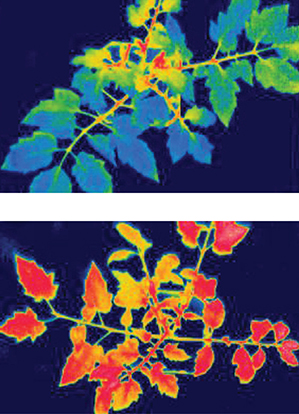How Can Crops Fare Better in Droughts?
Droughts that devastate crop production will only get worse in years to come. Last year, California’s worst drought in decades cost the state’s farmers $1 billion in lost revenue on top of the cost of pumping water to keep crops alive, a study from the University of California, Davis, showed.

Some drought tolerance has been bred into crops over time. In fact, agriculture companies such as Monsanto, DuPont Pioneer, and Syngenta sell varieties of corn that are billed as drought-tolerant. They are thought to modestly help farmers maintain yields in dry conditions. But in hopes of significantly raising the quality and quantity of food grown with less water, scientists are still looking for new breeding methods and biotechnologies. Their goal is for corn and other crops—especially wheat and rice—to withstand low rainfall even better without hurting the yield under normal conditions.
Here is some recent research that indicates the progress being made.
Retaining water on demand
Plants usually consume only a small portion of the water they take in and release the rest into the air through pores in their leaves, called stomata. During dry periods, many plants naturally produce a hormone called abscisic acid (ABA), which binds with a receptor in the plant and closes the stomata so that water can’t escape. Now researchers at the University of California, Riverside, have genetically modified the flowering plant Arabidopsis, common in lab experiments, so that it reacts to a common fungicide as if it were ABA. The idea is that it could become possible to trigger drought tolerance on demand in crops that do not already have it. The Nature study was published in February.
Drier climates
Researchers in Australia and the U.K. have found that they may be able to engineer plants to fare better in a future in which some areas are much drier and the entire atmosphere contains more carbon dioxide. The researchers modified a gene that controls the density of a plant’s stomata. By getting the gene to “over-express” itself, they made it possible for the plant to retain more water, implying that it would do well in drought conditions. The work was done in Arabidopsis leaves, but the research team will now test the genetic modification in a widely used crop (it has not disclosed which one) to observe its yield and quality, says Peter Franks, an associate professor at the University of Sydney and lead author of a paper published in New Phytologist.
Water sensor
Duke researchers have identified the gene linked with plants’ ability to sense how much water is available. Plants increase their cells’ calcium levels when water is scarce, which in turn sets off other responses that can help them survive. Duke associate professor Zhen-Ming Pei says further research on the gene could lead to crops that respond to drought more quickly. The research was published in Nature last August.
Scanning for genes
New DNA-analysis technologies are helping researchers identify genes or gene variations that might be useful for breeding better crops. In a recent PLOS ONE paper, breeding experts from Texas A&M looked into whether low local corn yields could be explained by the fact that Texas farmers were using varieties designed for Midwestern states, which have cooler and wetter growing periods. The scientists identified certain genetic markers that could be tied to traits—including drought tolerance—that would increase corn production in Texas’s climate. They used that information to develop a new type of corn that will undergo testing in Texas this summer.
The Takeaway:
Science can help crops withstand drought conditions. But developing new versions generally takes a long time—as much as seven years for new varieties in development today, says Texas A&M University’s Seth Murray.
Even varieties made to withstand drought still need some water to survive. Still, these varieties could make a difference in areas where irrigation or watering is not economical. In March, the International Maize and Wheat Improvement Center launched a five-year program to provide drought-resistant corn to about 400,000 small farms in Africa.
Do you have a big question? Send suggestions to questionoftheweek@technologyreview.com.
Keep Reading
Most Popular
Large language models can do jaw-dropping things. But nobody knows exactly why.
And that's a problem. Figuring it out is one of the biggest scientific puzzles of our time and a crucial step towards controlling more powerful future models.
The problem with plug-in hybrids? Their drivers.
Plug-in hybrids are often sold as a transition to EVs, but new data from Europe shows we’re still underestimating the emissions they produce.
Google DeepMind’s new generative model makes Super Mario–like games from scratch
Genie learns how to control games by watching hours and hours of video. It could help train next-gen robots too.
How scientists traced a mysterious covid case back to six toilets
When wastewater surveillance turns into a hunt for a single infected individual, the ethics get tricky.
Stay connected
Get the latest updates from
MIT Technology Review
Discover special offers, top stories, upcoming events, and more.